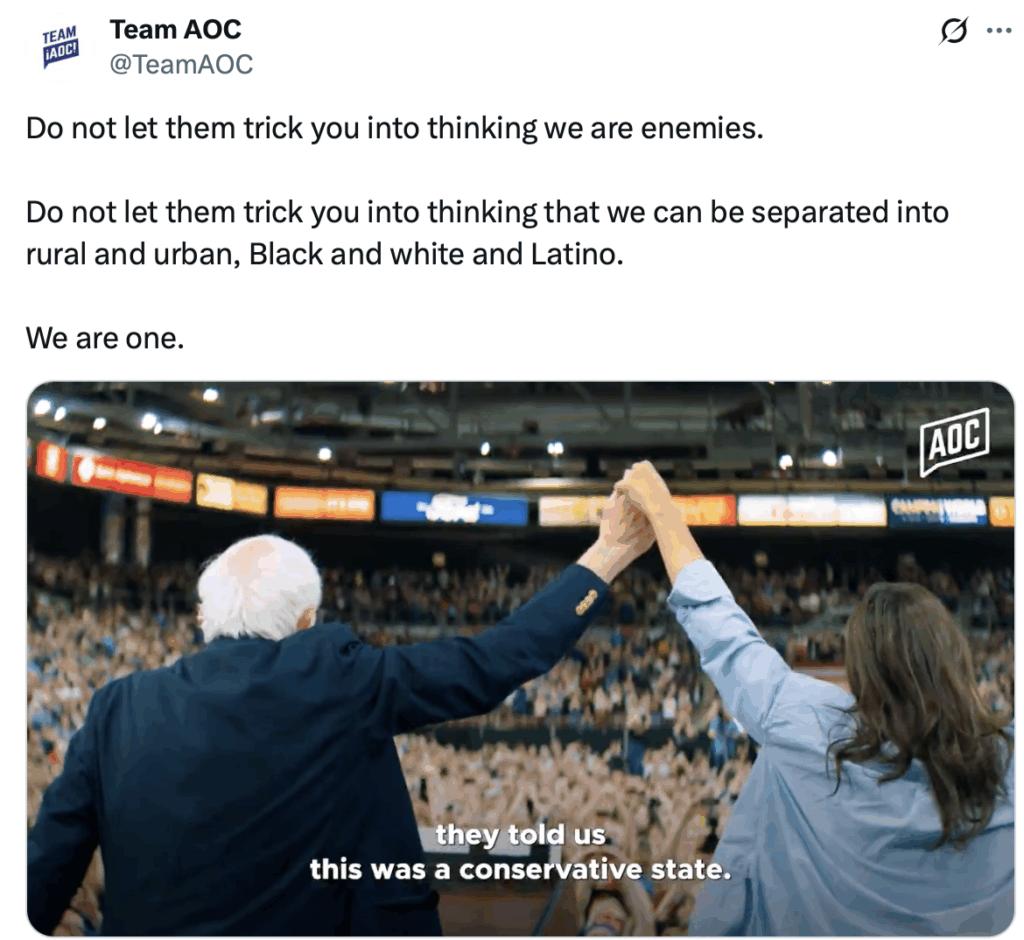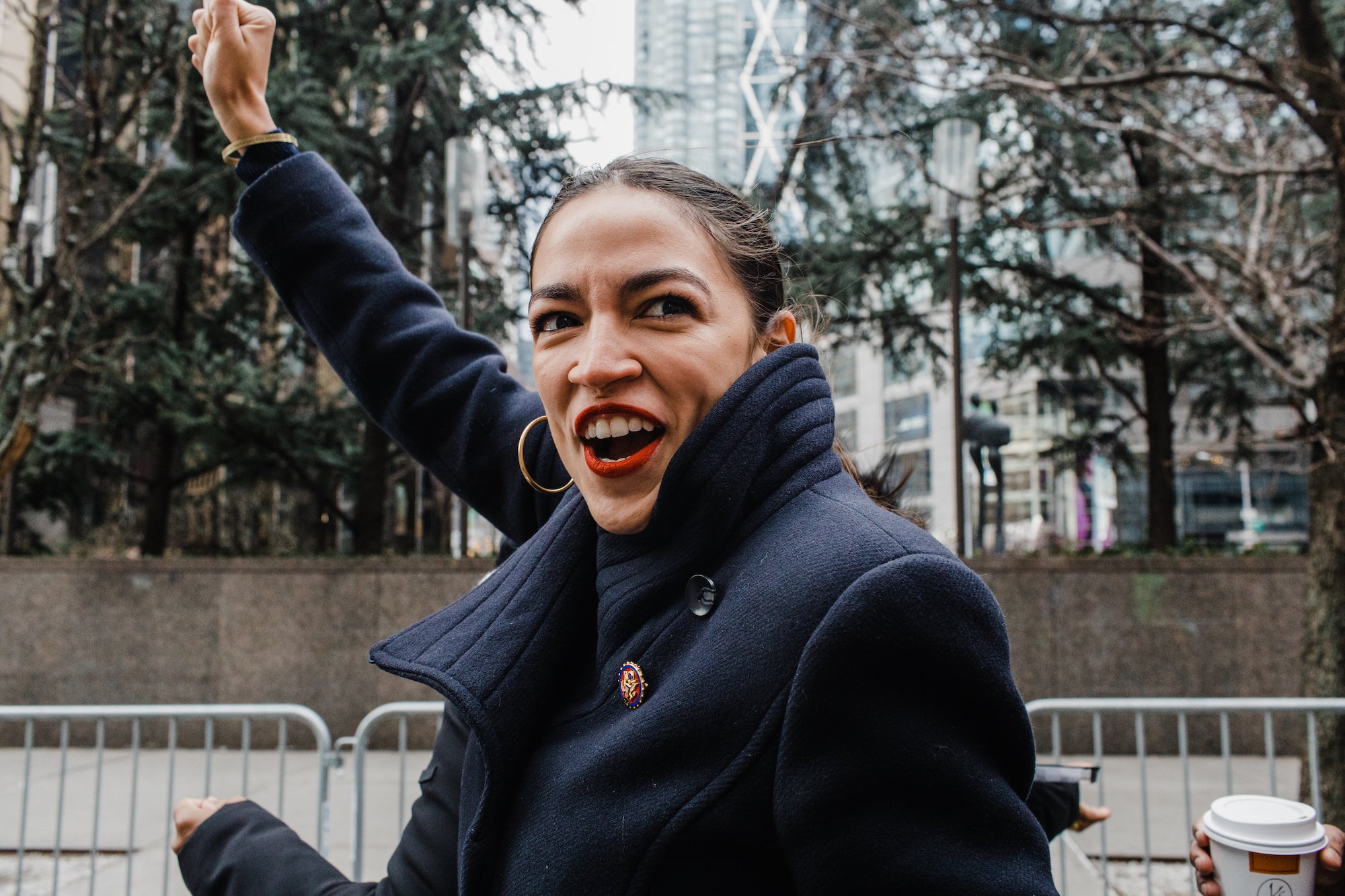Representative Alexandria Ocasio-Cortez (D-NY) and Senator Bernie Sanders (I-VT) embarked on their jointly promoted “Fight Oligarchy Tour,” visiting several traditionally Republican-leaning states to rally support for a progressive agenda. Amid heightened political polarization, the two veteran lawmakers have drawn considerable media attention—not only for their policy proposals but also for the logistics of their travel arrangements and the content of their public communications.
One particular social media post by Ocasio-Cortez’s campaign account, @TeamAOC, has sparked vigorous debate and widespread commentary. In a video caption intended to emphasize national unity—“Do not let them trick you into thinking that we are enemies. Do not let them trick you into thinking that we can be separated into rural and urban, Black and white and Latino. We are one.”—the deliberate capitalization of “Black” and “Latino” alongside a lowercase “white” was interpreted by many as inconsistent at best and racially divisive at worst.
This article provides a detailed, professional examination of the incident, exploring the political context, the core content of the post, the history and rationale behind racial capitalization, and the ensuing public reaction. We will assess the implications of this controversy for political messaging, intergroup relations, and the ongoing discourse around language, identity, and unity in American politics.
2. Context: The “Fight Oligarchy Tour” and Its Political Significance
The “Fight Oligarchy Tour” represents a concerted effort by Ocasio-Cortez and Sanders to spotlight economic inequality, corporate influence in politics, and voter mobilization in battleground jurisdictions. Beginning in early May 2025, the tour has included stops in states such as Idaho, Wyoming, and Montana—regions where Democrats traditionally face uphill electoral battles.
2.1 Goals and Themes
-
Economic Justice: Calling for progressive taxation, higher minimum wages, and stronger social safety nets.
-
Campaign Finance Reform: Advocating for limits on “dark money” and increased transparency in political donations.
-
Healthcare Expansion: Promoting Medicare for All and the reduction of prescription drug costs.
-
Voter Engagement: Encouraging turnout among younger voters, working-class communities, and historically underrepresented groups.
2.2 Logistics and Criticisms
-
The use of chartered or private flights to reach dispersed venues has generated commentary on environmental impact and resource allocation—questions Ocasio-Cortez and Sanders have addressed by offsetting carbon emissions and underscoring the logistical challenges of touring rural areas.
-
Despite their longstanding alignment on policy, the optics of seasoned national figures drawing criticism for their travel methods have become part of the broader narrative surrounding authenticity and accountability in progressive politics.
Against this backdrop, a seemingly innocuous social media caption became a flashpoint, illustrating the potency of language choices in contemporary political discourse.
3. The Content of the Contested Post

, @TeamAOC shared a short video clip from the tour stop in Boise, Idaho, accompanied by the following text (emphasis original):
“Do not let them trick you into thinking we are enemies. Do not let them trick you into thinking that we can be separated into rural and urban, Black and white and Latino. We are one.”
While the intended message—resisting divisive “us versus them” narratives—aligned with themes of unity and cross-demographic solidarity, the specific treatment of the racial identifiers (“Black,” “white,” “Latino”) prompted scrutiny. Observers noted that, by capitalizing “Black” and “Latino” but leaving “white” in lowercase, the post appeared to assign different levels of recognition and respect to these groups, undermining the stated call for togetherness.
The ensuing backlash took several forms:
-
Social Media Responses: Users highlighted the inconsistency, accusing the campaign of tacitly demeaning “white” as a non-legitimate identity while elevating other groups.
-
Commentary from Academics and Pundits: Several commentators—ranging from psychology professors to legal analysts—pointed out that such distinctions in capitalization can reinforce unequal power dynamics and feed perceptions of deliberate exclusion.
-
Media Coverage: Outlets across the ideological spectrum covered the story, framing it as symptomatic of broader challenges in progressive messaging and the Democrats’ struggle to maintain cohesion among a diverse coalition.
4. The Capitalization Issue: Black, Latino, and “white”
4.1 Symbolic Significance of Capitalization
In written English, capitalization can convey respect, personhood, or proper noun status. Over the past several years, major style guides have revisited their guidance on racial and ethnic identifiers, often responding to evolving social norms and identity politics.
-
“Black”: Capitalization is now widely adopted to affirm Black people as a distinct cultural and political community with a shared heritage.
-
“Latino/Latina/Latinx”: Capitalization reflects recognition of a pan-ethnic identity that transcends national origin, emphasizing solidarity among Spanish-language heritage groups.
-
“white” vs. “White”: Debate continues over whether “white” should be capitalized to acknowledge White identity politics and socioeconomic privilege, or lowercased as a default for historically dominant groups.
4.2 Interpretations of the Omitted Capitalization
Critics of the post argued that:
-
Inconsistent Recognition: By capitalizing some group labels and not others, the post implied that “white” is not a legitimate collective identity on par with “Black” or “Latino.”
-
Perpetuation of Division: The very mechanism intended to overcome division—collective labels—was undermined by the uneven treatment of those labels.
-
Unintentional Bias: Even if accidental, the omission risked reinforcing perceptions of racial favoritism and alienated potential supporters.
Proponents of selective capitalization counter that:
-
Historical Context: Lowercasing “white” can be seen as a corrective to centuries of assumed neutrality and default status, whereas capitalizing marginalized groups acknowledges their distinct experiences and contributions.
-
Editorial Consistency: Some publications (e.g., The New York Times) have updated internal stylebooks to capitalize “Black” while leaving “white” lowercase—mirroring the approach taken in the social media post.
Regardless of intent, the episode highlights the sensitivities surrounding identity terminology in public communication.
5. Historical and Style-Guide Perspectives on Racial Capitalization
5.1 Timeline of Major Style-Guide Changes
-
Associated Press (AP) Stylebook (July 2020): Capitalized “Black” in reference to people and culture; left “white” lowercase, citing consistency with lowercasing other racial and ethnic terms (e.g., “yellow,” “brown”).
-
Chicago Manual of Style (September 2022): Adopted a parallel approach, capitalizing “Black” and “Indigenous” as identities of particular historical and cultural significance; recommended lowercase for “white” to avoid implying symmetry.
-
American Psychological Association (APA) Publication Manual (7th edition, October 2019): Encouraged capitalization of racial and ethnic group names; did not explicitly address “white.”
5.2 Rationales Behind Capitalization Policies
-
Acknowledgment of Collective Identity: Capital letters denote a shared history of social struggle and cultural cohesion for marginalized groups.
-
Distinction from Color Descriptors: Prevents conflation between race as a social construct and mere color adjectives (e.g., “white car,” “black coffee”).
-
Alignment with Community Preferences: Surveys of editorial boards and community leaders have often favored capitalizing group names to signal respect.
5.3 Continuing Debate
Despite widespread adoption, some scholars and editors argue that lowercase “white” inadvertently erases White identity politics—particularly in contexts analyzing racial privilege, systemic bias, or demographic research. This ongoing debate underscores the lack of universal consensus and the importance of clear, intentional style choices in public messaging.
6. Public Reaction and Criticism
6.1 Social Media Backlash
Following the post’s publication:
-
Hashtags and Trends: Users invoked hashtags such as #CapitalizationMatters and #UnityHypocrisy to criticize the perceived inconsistency.
-
Political Satire: Meme accounts and satirists created parodies highlighting the irony of proclaiming unity while employing divisive grammar.
6.2 Commentary from Academics and Influencers
-
Psychological Perspective: Dr. Geoffrey Miller, a psychology professor, noted that language choices can unconsciously signal in-group versus out-group distinctions—a phenomenon well documented in social cognition literature.
-
Legal and Civil-Rights Analysis: Civil-rights attorneys pointed out that, even absent explicit discrimination, messaging that treats demographic groups differently may foster distrust and perceptions of unequal treatment.
6.3 Response from Ocasio-Cortez’s Office
Shortly after the criticism intensified, a staff spokesperson clarified that the omission of capitalization for “white” was an inadvertent oversight rather than a deliberate editorial policy. The campaign subsequently corrected the post to capitalize all three identifiers—aiming to realign the message with its original spirit of inclusivity.
7. The Broader Debate Over Language, Identity, and Unity
7.1 Language as a Tool of Inclusion and Exclusion
Language choices—terminology, tone, and grammar—play a pivotal role in shaping public perceptions. In multicultural societies, communicators must balance:
-
Recognition of Diversity: Valuing distinct histories and experiences.
-
Promotion of Cohesion: Emphasizing shared humanity and common purpose.
7.2 Identity Politics and Coalition Building
Political coalitions often rely on group-based appeals to mobilize supporters. However:
-
Excessive Emphasis on Difference: Can alienate other segments of the electorate and limit broad appeal.
-
Overgeneralization of Solidarity: Risks minimizing the specific challenges faced by particular communities.
Finding equilibrium requires nuanced messaging that honors subgroup identities while reiterating overarching objectives—whether economic justice, climate action, or democratic freedoms.
8. Political Implications for the Democratic Party
8.1 Risks of Messaging Missteps
In a deeply divided electorate, seemingly minor communication errors can:
-
Fuel Opponent Narratives: Republicans and conservative media may seize on missteps to portray Democrats as intolerant or elitist.
-
Demoralize Key Constituencies: Voters from all backgrounds seek sincerity and consistency; repeated controversies can erode trust.
8.2 Opportunities for Course Correction
-
Embrace Transparency: Prompt acknowledgment of mistakes and clear explanations can reinforce authenticity.
-
Engage in Dialogue: Soliciting feedback from diverse community leaders on language preferences fosters goodwill.
-
Standardize Internal Guidelines: Adopting consistent style sheets for campaign communications minimizes future errors.
9. Communication Best Practices for Political Messaging
Drawing lessons from this episode, political communicators should consider the following guidelines:
-
Establish a Style Guide
-
Develop a concise document specifying capitalization, preferred terminology, and inclusive language standards.
-
Circulate it among all staff involved in social media, press releases, and speeches.
-
-
Implement a Review Process
-
Route all public posts through an editorial team trained in the style guide.
-
Include a fact-checking step to verify both content accuracy and adherence to linguistic policies.
-
-
Stay Informed on Evolving Norms
-
Monitor updates from major style authorities (AP, Chicago, APA) and advocacy organizations representing various demographic groups.
-
Evaluate whether new recommendations align with the campaign’s values and messaging objectives.
-
-
Prioritize Consistency and Clarity
-
Avoid ad hoc changes to capitalization or terminology unless guided by deliberate policy shifts.
-
Use plain language that conveys respect for all audiences, minimizing jargon and ambiguous phrasing.
-
-
Engage Constituencies Directly
-
Host listening sessions with community stakeholders to understand their perspectives on identity language.
-
Acknowledge that preferences may vary by region, age, or cultural background—and adapt messaging accordingly.
-
By institutionalizing these practices, political campaigns and public offices can reduce the risk of avoidable controversies and strengthen their reputational resilience.
10. Conclusion
The controversy surrounding Representative Alexandria Ocasio-Cortez’s social media post—intended as a unifying message but marred by inconsistent capitalization of racial identifiers—serves as a cautionary tale for communicators in today’s hypercharged political environment. Even well-meaning content can elicit unintended backlash when nuanced questions of identity and recognition intersect with partisan scrutiny.
A thorough understanding of the historical, stylistic, and psychological dimensions of racial and ethnic terminology is indispensable. Public figures and their teams must remain vigilant, employing clear style guides, robust review processes, and ongoing engagement with the communities they seek to serve.
Ultimately, the capacity to unite diverse constituencies under common causes—economic equity, environmental stewardship, or democratic reform—depends not only on policy substance but also on the credibility and inclusivity of the messenger. As the Democratic Party reflects on lessons from this episode, it will need to reinforce both its commitment to diversity and its dedication to transparent, consistent communication—ensuring that calls for unity are matched by actions and language that embody it.

Adrian Hawthorne is a celebrated author and dedicated archivist who finds inspiration in the hidden stories of the past. Educated at Oxford, he now works at the National Archives, where preserving history fuels his evocative writing. Balancing archival precision with creative storytelling, Adrian founded the Hawthorne Institute of Literary Arts to mentor emerging writers and honor the timeless art of narrative.
